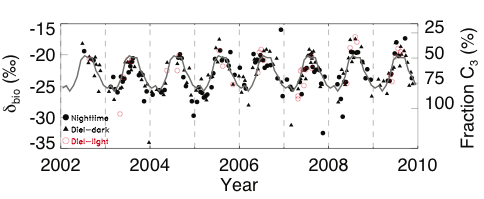Seasonal and Interannual Variability in 13C of Ecosystem Carbon Fluxes from 2002-2009
Submitter:
Torn, Margaret S. — Lawrence Berkeley National Laboratory
Area of research:
Surface Properties
Journal Reference:
Science
To understand the ongoing buildup of CO2 in the atmosphere, we need to better quantify fossil fuel emissions and how much CO2 is taken up by terrestrial and oceanic systems. One indicator of these sources and sinks is the 13C carbon isotope ratio of atmospheric CO2 (13C-CO2). For example, inverse and forward models have used 13C-CO2 observations to distinguish oceanic and terrestrial sink processes because they have different discrimination against 13C relative to 12C. Furthermore, 13C-CO2 gives insight into terrestrial processes, because C3 vegetation, like winter wheat and many other crops, discriminates more than C4 (e.g., prairie grasses) vegetation during photosynthesis. Finally, long-term changes in terrestrial 13CO2 fluxes also occur because of land-use change. To interpret 13C-CO2 observations, information about the isotopic signature of ecosystem carbon exchanges (13C-flux) is required, yet such information is rare. In fact, many studies conclude that the application of the 13C tracer is limited by insufficient measurements of 13CO2 fluxes. The U.S. Southern Great Plains is an important location for 13C measurements because it represents regions of historical conversion of prairie to agriculture, it is a heterogeneous landscape with a variety of land uses, and the ARM measurements allow a synthetic analysis of the sources and sinks of 13CO2.
Impact
With support from the U.S. DOE ARM Climate Research Facility and Atmospheric System Research Program, Torn et al. (2011) collected and analyzed the longest published record of 13CO2 flux measurements. From 2002 to 2009, Torn et al. measured atmospheric CO2 and 13C-CO2 concentrations weekly at four heights from the ARM Central Facility tower and computed the 13CO2flux. The observed seasonal cycle of 6–8% in 13CO2 flux was much larger than that assumed in regional and global inversion models. Winter wheat and other C3 vegetation (mainly crops) contributed ~80% of CO2 fluxes in winter-spring and ~50% in summer-fall. In contrast, historical prairie productivity was ~85% C4 year-round with much more enriched δ13CO2 flux values. These observations can greatly reduce uncertainty in land versus ocean partitioning of carbon sources and sinks.
Summary
While the isotope measurements showed that the proportions of C3 and C4 vegetation were relatively constant from year to year, there was large inter-annual variability in total 13CO2 flux due to large variability in total ecosystem productivity between wet and dry years. Within years, land-surface modeling showed that the seasonal amplitude of total 13C-fluxes in this region is very large, because the CO2 flux and its isotopic composition covary, and thus inverse analyses would need more accurate estimates of land cover than are currently used in order to predict 13CO2 and CO2 fluxes accurately. In summary, the investigation showed how changes in land use over the last 120 years and seasonal variations in current vegetation cover have a large effect on the 13CO2 flux, and that these effects are not accurately captured in models. These effects are significant and need to be accounted for in future analyses of terrestrial CO2 sinks.


